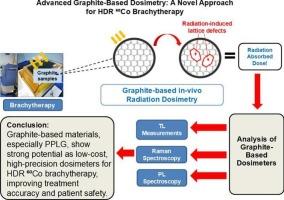Advanced graphite-based dosimetry: A novel approach for HDR 60Co brachytherapy
IF 5.1
3区 材料科学
Q2 MATERIALS SCIENCE, COATINGS & FILMS
引用次数: 0
Abstract
High-dose-rate (HDR) 60Co brachytherapy is widely used for cancer treatment, offering precise radiation delivery to tumors while minimizing exposure to surrounding healthy tissues. However, steep dose gradients and limited real-time dose verification pose significant challenges, making accurate in vivo dosimetry essential for treatment safety and efficacy. This study investigates the potential of graphite-based materials for in vivo dosimetry in HDR 60Co brachytherapy, aiming to achieve accurate and reliable radiation dose measurements. Thermoluminescence (TL) and photoluminescence (PL) responses, along with Raman and Fourier-transform infrared (FTIR) spectroscopic features, were analyzed to evaluate the correlation between radiation exposure and structural modifications within a dose range of 0.5 to 10 Gy. Two commercially available graphite-based materials i.e. 50 μm thick graphite sheets (GS) and 0.3 mm diameter 2B-grade polymer pencil lead graphite (PPLG) were examined for their dosimetric suitability. Results indicate that defect states in these materials significantly influence their luminescent properties, with PPLG exhibiting superior TL sensitivity, stability, and linear dose response compared to graphite sheets. Raman and FTIR spectroscopy further confirm radiation-induced structural changes, correlating with TL and PL behaviors. These findings suggest the preliminary potential of graphite-based materials, particularly PPLG, for radiation dosimetry using an HDR 60Co source. The results indicate that PPLG may serve as a cost-effective and high-precision dosimetric material, with promising applicability in HDR 60Co brachytherapy to support improved treatment accuracy and patient safety.

先进的石墨基剂量学:HDR 60Co近距离治疗的新方法
高剂量率(HDR) 60Co近距离放射治疗广泛用于癌症治疗,提供精确的肿瘤放射,同时最大限度地减少对周围健康组织的暴露。然而,陡峭的剂量梯度和有限的实时剂量验证带来了重大挑战,使得准确的体内剂量测定对治疗安全性和有效性至关重要。本研究探讨了石墨基材料在HDR 60Co近距离放射治疗中的体内剂量测定潜力,旨在实现准确可靠的放射剂量测量。分析了热释光(TL)和光释光(PL)响应,以及拉曼和傅里叶变换红外(FTIR)光谱特征,以评估0.5至10 Gy剂量范围内辐射暴露与结构修饰之间的相关性。研究了两种市售石墨基材料,即50 μm厚的石墨片(GS)和0.3 mm直径的2b级聚合物铅笔芯石墨(PPLG)的剂量学适用性。结果表明,这些材料中的缺陷状态显著影响其发光性能,与石墨片相比,PPLG具有更好的TL灵敏度、稳定性和线性剂量响应。拉曼光谱和FTIR光谱进一步证实了辐射引起的结构变化,与TL和PL行为相关。这些发现表明,石墨基材料,特别是PPLG,在使用HDR 60Co源进行辐射剂量测定方面具有初步的潜力。结果表明,PPLG可作为一种高性价比、高精度的剂量学材料,在HDR 60Co近距离治疗中具有良好的应用前景,以支持提高治疗准确性和患者安全性。
本文章由计算机程序翻译,如有差异,请以英文原文为准。
求助全文
约1分钟内获得全文
求助全文
来源期刊

Diamond and Related Materials
工程技术-材料科学:综合
CiteScore
6.00
自引率
14.60%
发文量
702
审稿时长
2.1 months
期刊介绍:
DRM is a leading international journal that publishes new fundamental and applied research on all forms of diamond, the integration of diamond with other advanced materials and development of technologies exploiting diamond. The synthesis, characterization and processing of single crystal diamond, polycrystalline films, nanodiamond powders and heterostructures with other advanced materials are encouraged topics for technical and review articles. In addition to diamond, the journal publishes manuscripts on the synthesis, characterization and application of other related materials including diamond-like carbons, carbon nanotubes, graphene, and boron and carbon nitrides. Articles are sought on the chemical functionalization of diamond and related materials as well as their use in electrochemistry, energy storage and conversion, chemical and biological sensing, imaging, thermal management, photonic and quantum applications, electron emission and electronic devices.
The International Conference on Diamond and Carbon Materials has evolved into the largest and most well attended forum in the field of diamond, providing a forum to showcase the latest results in the science and technology of diamond and other carbon materials such as carbon nanotubes, graphene, and diamond-like carbon. Run annually in association with Diamond and Related Materials the conference provides junior and established researchers the opportunity to exchange the latest results ranging from fundamental physical and chemical concepts to applied research focusing on the next generation carbon-based devices.
 求助内容:
求助内容: 应助结果提醒方式:
应助结果提醒方式:


